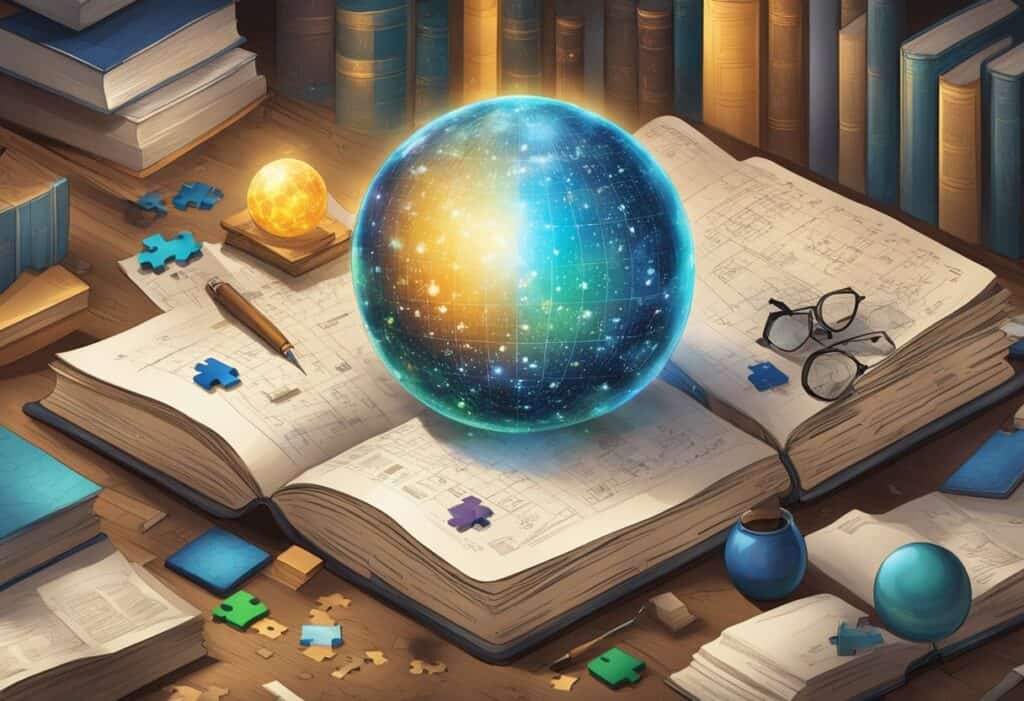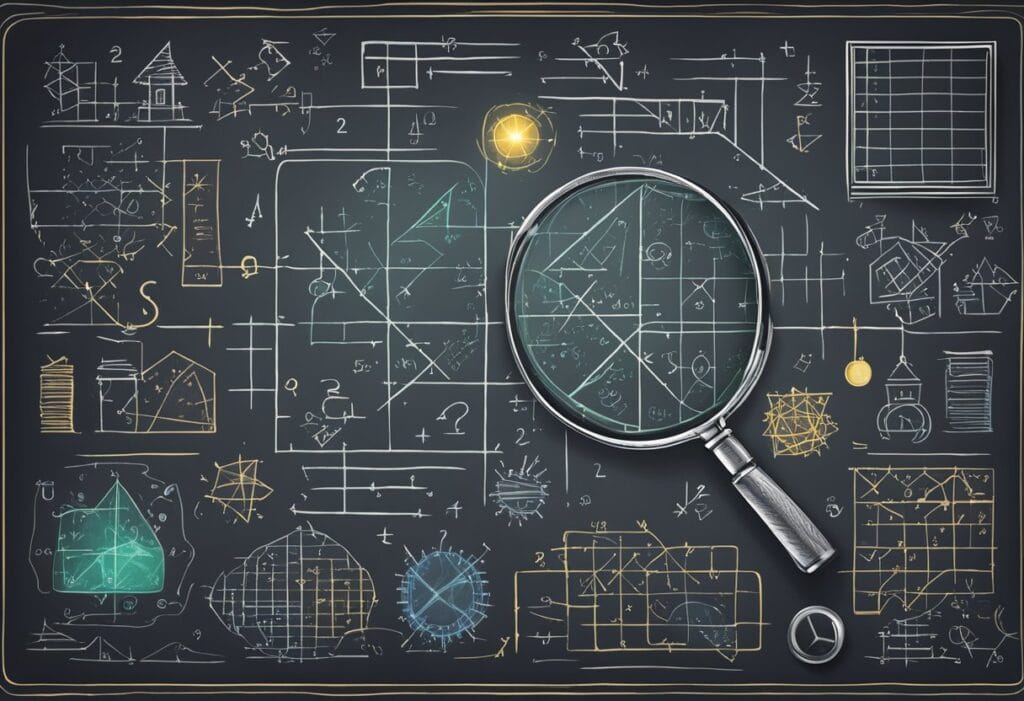Solving the Universe’s Most Perplexing Puzzles!

Imagine a world where the enigmatic whispers of the universe are decoded, one algorithm at a time. AI: The Cosmic Codebreaker has arrived, not just to challenge our understanding but to revolutionize it.
Embark on a journey through the stars as we explore how artificial intelligence is pioneering the quest to solve the cosmos’ most bewildering enigmas. With each byte and bit, AI is unraveling the fabric of space, offering astonishing insights into the dark corners of the universe that have long eluded us.
Can Knowledge Integration Help Clear Up Unsolved Puzzles and Problems?
Discover the Power of Knowledge Integration
Get ready to be amazed! Knowledge Integration (KI) is changing the game when it comes to solving some of the world’s most baffling puzzles. By weaving together insights from different fields, KI is helping us crack problems that have left experts scratching their heads for years. This groundbreaking approach is opening doors to solutions that once seemed out of reach.
Unleashing the Hidden Potential of Data
Imagine finding hidden gems of insight in a sea of data. KI gathers and analyzes information from all sorts of sources, revealing patterns and connections we’ve never seen before. This thorough process helps us see the bigger picture, providing clarity and solutions to long-standing issues.
Bridging Disciplines for Innovative Solutions
Feel the thrill as KI brings together different fields to spark new ideas!
- Interdisciplinary Breakthroughs: By integrating knowledge from various disciplines, KI encourages breakthroughs that wouldn’t happen otherwise.
- Health Puzzle Solutions: Blending biology, chemistry, and AI could lead to new medical treatments, solving health puzzles that have stumped us for years.
Accelerating Problem-Solving with Advanced Tools
Marvel at the advanced tools KI creates!
- Sophisticated Algorithms: These tools tackle complex problems head-on.
- Enhanced Prediction: They boost our problem-solving skills, letting us predict outcomes and come up with strategies more accurately than ever before.
Collaboration: The Key to Unraveling Mysteries
Experience the magic of teamwork!
- Expert Collaboration: KI brings experts from different fields together, fostering collaboration that leads to comprehensive solutions.
- Combined Expertise: When bright minds come together, their combined expertise unlocks answers to even the toughest puzzles.
Historical Insights Meet Modern Research
Watch as the past meets the present!
- Long-Term Perspective: KI blends historical data with modern research, offering a long-term view that’s crucial for tackling persistent problems.
- Effective Solutions: This mix of old and new knowledge helps us develop solutions that are both effective and sustainable.
Sparking Creativity and Innovation
Get inspired by the creativity KI ignites!
- Diverse Knowledge Integration: By integrating diverse knowledge, KI leads to unique and inventive solutions.
- Thinking Outside the Box: This approach encourages thinking outside the box, making it possible to solve problems in ways we never imagined.
AI: The Game-Changer in Solving Unsolved Mysteries and Puzzles

Discover How AI is Unraveling Mysteries
Artificial Intelligence (AI) is revolutionizing our ability to solve some of the world’s most baffling puzzles. By harnessing the power of advanced algorithms and integrating diverse data sources, AI is providing solutions that have eluded experts for decades. This groundbreaking technology is opening doors to discoveries we never thought possible.
Medical Breakthroughs That Astonish
Personalized Cancer Treatment
Imagine a world where cancer treatments are tailored specifically to each patient. AI makes this possible by analyzing genetic data and clinical research to identify the most effective treatments. IBM’s Watson for Oncology uses AI to recommend personalized treatment plans, significantly improving patient outcomes and reducing side effects Read more.
Predicting Disease Outbreaks
Experience the future of epidemic prevention! During the COVID-19 pandemic, AI was instrumental in predicting outbreaks. BlueDot, a Canadian AI company, used machine learning to analyze news reports, airline data, and animal disease networks. Remarkably, BlueDot identified the outbreak in Wuhan days before the WHO issued a warning, enabling quicker responses to control the spread Read more.
Environmental Solutions That Inspire
Climate Change Models
Feel the power of AI in fighting climate change! AI enhances climate models by integrating vast amounts of data from meteorology, oceanography, and environmental economics. Google’s DeepMind improves weather forecasts and climate models, providing more accurate predictions of extreme weather events and long-term climate patterns. This critical information supports effective policy-making to mitigate climate change Read more.
Wildlife Conservation
Witness AI saving endangered species! AI analyzes satellite imagery, camera trap photos, and acoustic data to monitor wildlife. Google Cloud’s Wildlife Insights platform processes millions of images to identify animals and track their movements. This real-time data helps conservationists protect critical habitats and develop strategies to save endangered species Read more.
Technological Innovations That Excite
AI in Healthcare
Marvel at AI transforming healthcare! AI-driven diagnostic tools analyze medical images and patient data to detect diseases early. Google’s DeepMind developed an AI system that diagnoses eye diseases from retinal scans with expert-level accuracy. This technology enables early detection and treatment of conditions like diabetic retinopathy, preventing vision loss in millions of patients Read more.
Smart Grid Technology
Discover the future of energy efficiency! AI optimizes smart grids by integrating data from energy production, consumption patterns, and weather forecasts. Siemens uses AI to manage electricity demand, predict energy consumption, and optimize renewable energy distribution. This results in more efficient energy use, reduced waste, and increased power grid reliability Read more.
Historical and Social Research That Surprises
Archaeological Discoveries
Uncover hidden ancient civilizations! AI reveals hidden archaeological sites by analyzing satellite imagery and historical data. The GlobalXplorer platform, developed by space archaeologist Sarah Parcak, uses AI to scan satellite images for signs of ancient structures. This technology has led to the discovery of thousands of unknown archaeological sites, shedding light on ancient civilizations Read more.
Social Policy Analysis
Revolutionize social policy with AI! AI evaluates the impact of social policies by analyzing extensive datasets from economic, social, and political research. The Abdul Latif Jameel Poverty Action Lab (J-PAL) uses AI to assess interventions like cash transfers and education programs. By synthesizing data from randomized controlled trials, AI provides insights that guide policymakers in designing effective social programs Read more.
- IBM’s Watson for Oncology: Read more
- BlueDot: Read more
- Google’s DeepMind Climate Forecasting: Read more
- Wildlife Insights: Read more
- DeepMind AI for Eye Health: Read more
- Siemens Smart Grid AI: Read more
- GlobalXplorer: Read more
- J-PAL: Read more
Let’s explore some more examples of how AI has been instrumental in unraveling mysteries and solving unsolved puzzles

- Gravitational Waves and Black Holes:
- Mystery: For centuries, scientists speculated about the existence of black holes and their gravitational waves. These cosmic phenomena were elusive and challenging to detect.
- AI’s Role: AI algorithms, such as those used in the LIGO (Laser Interferometer Gravitational-Wave Observatory), helped detect gravitational waves from merging black holes. AI analyzed massive data sets, identified subtle patterns, and confirmed Einstein’s predictions.
- Protein Folding and Drug Discovery:
- Mystery: Understanding how proteins fold into their functional shapes is crucial for drug development and disease treatment.
- AI’s Role: Deep learning models, like AlphaFold, predict protein structures with remarkable accuracy. This breakthrough accelerates drug discovery by identifying potential binding sites and interactions.
- Cosmic Microwave Background Radiation (CMB):
- Mystery: The CMB holds clues about the early universe, but extracting meaningful information from noisy data is challenging.
- AI’s Role: AI algorithms analyze CMB maps, separating signal from noise. They help cosmologists refine our understanding of the Big Bang and cosmic evolution.
- Archaeological Puzzles:
- Mystery: Deciphering ancient scripts and languages (such as Egyptian hieroglyphs or Mayan glyphs) has puzzled historians for centuries.
- AI’s Role: AI-driven language models learn from existing translations and decode previously indecipherable texts. For example, Google’s Rosetta Stone project aims to unlock ancient languages.
- Dark Matter and Energy:
- Mystery: Dark matter and dark energy constitute most of the universe, yet their nature remains unknown.
- AI’s Role: AI analyzes galaxy clusters, gravitational lensing, and cosmic microwave background data to probe dark matter’s properties. It’s a cosmic detective, sifting through vast data sets for clues.
- Climate Change Modeling:
- Mystery: Predicting climate change impacts accurately requires complex models.
- AI’s Role: AI-enhanced climate models improve predictions by incorporating real-time data, satellite imagery, and ocean currents. It helps us understand Earth’s changing climate.
- Unsolved Mathematical Conjectures:
- Mystery: Problems like the Riemann Hypothesis or Collatz Conjecture have stumped mathematicians for decades.
- AI’s Role: AI explores vast solution spaces, testing conjectures and finding counterexamples. It collaborates with human mathematicians, pushing the boundaries of mathematical knowledge.
- Exoplanet Hunting:
- Mystery: Identifying distant exoplanets (planets beyond our solar system) is like finding needles in cosmic haystacks.
- AI’s Role: AI algorithms analyze light curves from telescopes, spotting tiny dips caused by transiting exoplanets. It’s a cosmic detective, revealing new worlds.
Let’s delve even deeper into the cosmic mysteries that AI is unraveling
AI: The Enigma Engine – Deciphering the Undeciphered, Illuminating the Unknown!

- Quantum Entanglement and Spooky Action at a Distance:
- Mystery: Quantum entanglement, where particles remain connected across vast distances, baffled Einstein himself.
- AI’s Role: AI algorithms simulate quantum states, aiding in understanding entanglement’s implications for communication and teleportation.
- The Great Fermi Paradox: Where Are the Aliens?
- Mystery: Given the vastness of the cosmos, why haven’t we encountered extraterrestrial civilizations?
- AI’s Role: AI scans radio signals, analyzes exoplanet data, and searches for techno-signatures. It’s our cosmic detective, seeking signs of intelligent life.
- The Nature of Dark Energy: Cosmic Acceleration
- Mystery: Dark energy pushes galaxies apart, accelerating cosmic expansion. What is it?
- AI’s Role: AI models explore dark energy’s behavior, testing theories and predicting its effects on the universe’s fate.
- The Multiverse Hypothesis: Parallel Realities
- Mystery: Could our universe be just one bubble in a vast multiverse?
- AI’s Role: AI simulates multiverse scenarios, exploring the fabric of reality beyond our cosmic horizon.
- The Ultimate Theory of Everything: Unifying Physics
- Mystery: Can we merge quantum mechanics and general relativity into a single framework?
- AI’s Role: AI crunches data, seeking patterns that bridge these fundamental theories. It’s the quest for a cosmic Rosetta Stone.
- The Missing Baryons: Where’s the Ordinary Matter?
- Mystery: Most matter in the universe is missing. It’s not dark matter; it’s ordinary baryonic matter.
- AI’s Role: AI analyzes cosmic microwave background data, revealing the hidden baryons and completing the cosmic inventory.
- Time Travel and Wormholes: Fiction or Feasible?
- Mystery: Can we warp spacetime to journey through time?
- AI’s Role: AI assists in modeling wormholes, exploring their stability and potential for time travel.
- The Great Galactic Ghoul: Dark Matter Halos
- Mystery: Dark matter halos envelop galaxies, shaping their structure. What’s inside?
- AI’s Role: AI simulations reveal the dynamics of dark matter halos, shedding light on galactic evolution.
- The Cosmic Web: Threads of Galaxy Clusters
- Mystery: How do galaxies arrange themselves into vast cosmic filaments?
- AI’s Role: AI maps the cosmic web, connecting galaxies like celestial threads in a grand tapestry.
- The Information Paradox: Black Holes and Hawking Radiation
- Mystery: Black holes devour information, yet Hawking radiation suggests they emit it. How?
- AI’s Role: AI explores quantum gravity, bridging classical and quantum physics to resolve this paradox.
AI: The Mind Behind the Math

Cracking Cosmic Codes & Conquering Chess Champions!
Fermat’s Last Theorem
Fermat’s Last Theorem, one of the most famous unsolved problems in mathematics, baffled mathematicians for centuries. Proposed by Pierre de Fermat in 1637, it states that no three positive integers a, b, and c can satisfy the equation a^n + b^n = c^n for any integer value of n greater than 2.
- Despite numerous attempts by mathematicians over the years, a proof remained elusive until 1994 when mathematician Andrew Wiles finally cracked the problem with the help of advanced mathematical techniques, some of which were made possible by computer algorithms and AI.
- While AI did not directly provide the proof, it played a role in exploring potential avenues and assisting with calculations that guided Wiles in his groundbreaking work.
Chess and AI
Chess has long been a battleground for testing the capabilities of AI. The development of chess-playing programs like IBM’s Deep Blue and Google’s AlphaZero has pushed the boundaries of what AI can achieve in strategic decision-making.
- These programs utilize advanced algorithms, neural networks, and machine learning techniques to analyze vast numbers of possible moves and outcomes, enabling them to compete at the highest levels against human grandmasters.
- Deep Blue famously defeated world chess champion Garry Kasparov in 1997, marking a significant milestone in the intersection of AI and strategic decision-making.
The Riemann Zeta Problem
The Riemann Hypothesis, formulated by German mathematician Bernhard Riemann in 1859, remains one of the most famous unsolved problems in mathematics. It proposes that the non-trivial zeros of the Riemann Zeta function all have a real part equal to 1/2.
- While the proof of this hypothesis remains elusive, AI has been employed to explore patterns and potential connections within the distribution of prime numbers, which are closely linked to the Riemann Zeta function.
- By applying machine learning algorithms to analyze large datasets of prime numbers and their properties, researchers hope to gain new insights that could lead to a breakthrough in solving this age-old puzzle.
The Travelling Salesman Problem (TSP)
The Traveling Salesman Problem (TSP) is a classic problem in combinatorial optimization that seeks to find the shortest possible route that visits a given set of cities and returns to the original city.
- While seemingly simple in concept, finding the optimal solution becomes exponentially complex as the number of cities increases.
- AI techniques such as genetic algorithms, simulated annealing, and ant colony optimization have been employed to tackle the TSP by exploring different combinations of routes and iteratively improving upon them.
- These algorithms have been instrumental in finding near-optimal solutions for large-scale instances of the TSP, with applications ranging from logistics and transportation planning to circuit design and DNA sequencing.
Protein Folding Problem
The Protein Folding Problem is a fundamental challenge in biochemistry that involves predicting the three-dimensional structure of a protein from its amino acid sequence. Understanding protein folding is crucial for drug discovery, as misfolded proteins are associated with numerous diseases, including Alzheimer’s and Parkinson’s.
- AI, particularly deep learning algorithms, has shown promise in predicting protein structures more accurately and efficiently than traditional methods.
- DeepMind’s AlphaFold, for example, uses deep learning to predict protein structures with remarkable accuracy, providing valuable insights into the molecular mechanisms underlying diseases and potential targets for drug development.
Crop Yield Prediction
Predicting crop yields accurately is essential for optimizing agricultural practices and ensuring food security. AI-powered models, such as those based on machine learning and satellite imagery analysis, have been developed to forecast crop yields with greater precision.
- These models take into account various factors, including weather patterns, soil composition, and historical yield data, to generate forecasts at both regional and global scales.
- By providing early warnings of potential crop failures or surpluses, AI helps farmers and policymakers make informed decisions to mitigate risks and optimize agricultural productivity.
Some famous unsolved problems in mathematics

Mathematics, the universal language of the mind, has long been a source of profound puzzles and enigmatic questions. While many have been solved through the ingenuity of human thought, some problems have resisted resolution, standing as sentinels on the frontier of mathematical knowledge.
These famous unsolved problems are not merely academic curiosities; they are beacons that guide the intellectual pursuits of mathematicians and scientists alike. They challenge our understanding of numbers, shapes, and patterns, and their solutions promise to unlock new realms of discovery.
- The Goldbach Conjecture:
- Problem: Every even integer greater than 2 can be expressed as the sum of two prime numbers.
- Status: Despite extensive computational verification, a general proof remains elusive.
- The Riemann Hypothesis:
- Problem: The nontrivial zeros of the Riemann zeta function lie on the critical line with real part 1/2.
- Significance: It has implications for prime number distribution and remains one of the most famous unsolved problems.
- Millennium Prize Problem: Part of the seven unsolved problems with a $1,000,000 reward for a solution.
- The P vs. NP Problem:
- Problem: Is every problem for which a solution can be verified quickly (in polynomial time) also solvable quickly (in polynomial time)?
- Significance: It has profound implications for computer science, cryptography, and optimization.
- The Hodge Conjecture:
- Problem: Given a smooth projective algebraic variety, certain cohomology classes can be represented by algebraic cycles.
- Status: Unsolved, but progress has been made in specific cases.
- The Yang-Mills Existence and Mass Gap Problem:
- Problem: Prove the existence of a quantum field theory for Yang-Mills fields with a nonzero mass gap.
- Significance: It relates to the behavior of elementary particles and gauge theories.
- The Navier-Stokes Existence and Smoothness Problem:
- Problem: Prove the existence and smoothness of solutions to the Navier-Stokes equations, describing fluid flow.
- Status: Unsolved for the full three-dimensional case.
- The Birch-Swinnerton-Dyer Conjecture:
- Problem: Relates the number of rational points on an elliptic curve to its L-series.
- Significance: It connects algebraic geometry and number theory.
Remember, these problems challenge mathematicians worldwide, and their solutions would significantly advance our understanding of mathematics and related fields.
What are some Millennium Prize Problems?
The Millennium Prize Problems are a set of seven of the most challenging mathematical problems, formulated by the Clay Mathematics Institute in 2000. Each problem carries a reward of $1 million for the first correct solution. Here are the problems, including the one that has been solved:
- Poincaré Conjecture (Solved):
- Problem: Every simply connected, closed 3-manifold is homeomorphic to the 3-sphere.
- Solver: Grigori Perelman provided a solution in 2003, which was confirmed to be correct, but he declined the prize money.
- Birch and Swinnerton-Dyer Conjecture:
- Problem: The rank of an elliptic curve over the rationals is related to the order of the zero of its L-function at s=1.
- Hodge Conjecture:
- Problem: Certain classes of non-algebraic cohomology classes are realized by algebraic cycles.
- Navier–Stokes Existence and Smoothness:
- Problem: Solve the three-dimensional Navier–Stokes equations for a solution that is smooth and globally defined.
- P vs NP Problem:
- Problem: Can every solved problem whose answer can be checked quickly by a computer also be solved quickly by a computer?
- Riemann Hypothesis:
- Problem: All non-trivial zeros of the analytical continuation of the Riemann zeta function have a real part of 1/2.
- Yang–Mills Existence and Mass Gap:
- Problem: Prove that for Yang-Mills theories in the quantum field, there exists a mass gap in the solution to the equations.
These problems are not only a testament to the complexity and depth of mathematics but also serve as milestones that, if solved, could lead to significant advancements in both mathematics and other sciences.
Conclusion: AI’s Impact on Solving Complex Problems
These examples highlight the diverse applications of AI in solving complex problems and unraveling mysteries across different domains. From healthcare and agriculture to language processing and fraud detection, AI continues to push the boundaries of what is possible, revolutionizing industries and driving innovation.
As AI technology continues to advance, we can expect even more remarkable breakthroughs that will reshape our understanding of the world and pave the way for a brighter and more prosperous future.
Resources:
- Clay Mathematics Institute – Millennium Prize Problems:
- The official page from the Clay Mathematics Institute (CMI) provides detailed information about each of the seven Millennium Prize Problems. It includes background, descriptions, and updates on progress.
- Wikipedia – Millennium Prize Problems:
- Wikipedia’s article covers the history, significance, and current status of the Millennium Prize Problems. It also highlights the solved Poincaré conjecture and the remaining unsolved problems.
- Brilliant Math & Science Wiki – Millennium Prize Problems:
- This wiki article offers concise explanations of each problem, including the Birch and Swinnerton-Dyer conjecture, Hodge conjecture, Navier–Stokes existence and smoothness, P versus NP problem, Riemann hypothesis, Yang–Mills existence and mass gap, and the Poincaré conjecture.